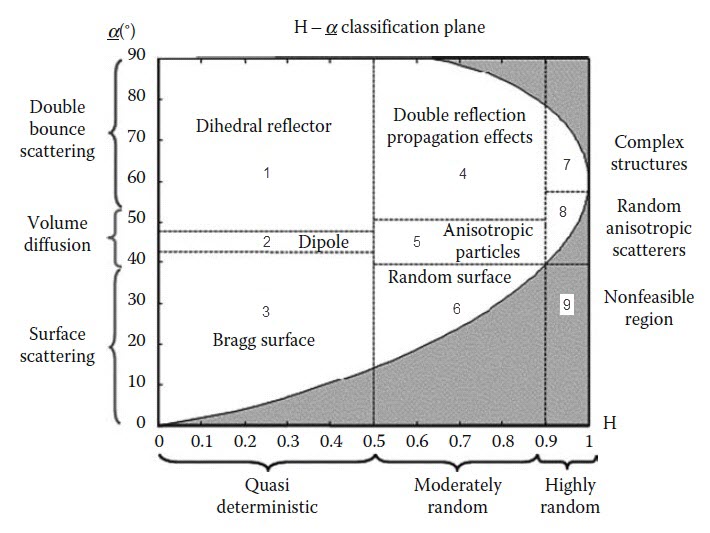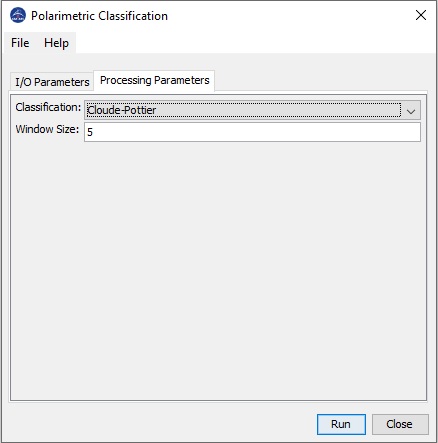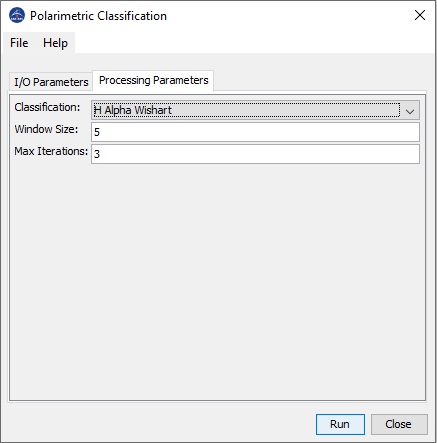Polarimetric Classification Operator
This operator performs the following polarimetric
classification for a full polarimetric SAR product:
- Unsupervised Cloude-Pottier Classification
- Unsupervised Whishart Classification
Cloude-Pottier Classification
The Cloude-Pottier classification is an unsupervised
classification scheme which is based on the use of the Entropy (H)
/ Alpha (
α
) plane. Entropy by definition is a natural measure of the inherent
reversibility of the scattering data while alpha can be used to
identify the underlying average scattering mechanisms. The H /
Alpha plane is divided into nine zones corresponding to nine
classes of different scattering mechanisms. For each pixel in the
source product, its entropy and alpha angle are computed. Based on
the position of the computed entropy and alpha in the H / Alpha
plane, the pixel is classified into one of the nine zones, a zone
index is assigned to the pixel. For detail calculations of entropy
and alpha, readers are referred to on-line help for Polarimetric
Decomposition operator. Figure 1 shows the locations and boundaries
of the nine zones in H / Alpha plane:

Figure 1. H / Alpha plane
H Alpha Wishart Classification
Similar to the Cloude-Pottier classification, the
unsupervised H Alpha Wishart classification also separates data
into nine clusters using the zones defined in the H / Alpha
plane above. Different from the Cloude-Pottier classification, the
H Alpha Wishart classification will continue to compute the centres
of the nine clusters, then reclassify the pixels based on their
Wishart distances to the cluster centres. This procedure will
repeat several times until the user defined total number of
iterations is reached. To achieve accurate classification result,
speckle filtering must be applied before the classification.
The cluster centre
Vm
for the
m
th cluster is the average of the coherency matrices
of all pixels in the cluster. Mathematically it is given by
The Wishart distance measure from coherency matrix
T
to cluster centre
Vm
is defined
as the following:
where ln() is the natural logarithm function, |.| and
Tr(.) indicate the determinant and the trace of the matrix
respectively.
Freeman-Durden Wishart Classification
The Freeman-Durden classification is also a Wishart distance
based classification. It basically implements the unsupervised
PolSAR classification algorithm proposed by Lee et al. in [2]. In
the algorithm, the pixels are first divided into three categories
of surface, volume and double bounce scattering by applying the
Freeman-Durden decomposition. Then 30 clusters are created in each
category with approximately equal number of pixels based on the
backscattering power of surface, volume and double bounce. Finally
the clusters in each category are merged to a pre-selected number
of classes based on Wishart distance between clusters.
General Wishart Classification
The General Wishart classification method
generalizes the Freeman-Durden Wishart classification method
above. In the General Wishart classification, the initial
decomposition method is generalized from Freeman-Durden method to
other decomposition method, such as Sinclair decomposition,
Yamaguchi decomposition etc. The rest of the algorithm is the same
as the Freeman-Durden classification algorithm.
Input and Output
- The input to this operator can be covariance matrix or
coherency matrix generated by Polarimetric Matrix Generation
operator.
- The output of this operator is a band with pixel values being
the cluster indices.
Parameters Used
For Cloude-Pottier classification, the following
processing parameter are needed (see Figure 2):
- Classification: the classification method
- Window Size: dimension of sliding window for computing mean
covariance or coherency matrix

Figure 2. Dialog box
for Cloude-Pottier classification
For H Alpha Wishart classification, the following parameters are
used (see Figure 3):
- Classification: the classification method
- Window Size: dimension of sliding window for computing mean
covariance or coherency matrix
- Maximum Number of Iterations: the maximum number of
iterations

Figure 3. Dialog box for H Alpha Wishart
classification
For the Freeman-Durden Wishart classification, the following
parameters are used (see Figure 4):
- Classification: the classification method
- Window Size: dimension of sliding window for computing mean
covariance or coherency matrix
- Initial Number of Classes: the initial number of clusters
- Final Number of Classes: the final number of classes after
classification
- Threshold for Mixed Category: the threshold used in classifying
pixels to the mixed category. The Freeman-Durden decomposition
computes for each pixel the contribution of three scattering
mechanisms: volume, surface and double-bounce. Based on the
dominant value of the three categories, the pixel is classified to
one of the categories. But for some pixels, there is no obvious
dominant value, in this case the pixel is classified to the mixed
category. Say the pixel has values Pv, Ps and Pd for the three
categories, if max(Pv, Ps, Pd) / (Pv + Ps + Pd) <= this
threshold, it is classified to the mixed category.

Figure 4. Dialog box for the Freeman-Durden Wishart
classification
For the General Wishart classification, the following parameters
are used (see Figure 4):
- Classification: the classification method
- Window Size: dimension of sliding window for computing mean
covariance or coherency matrixp
- Initial Number of Classes: the initial number of clusters
- Final Number of Classes: the final number of classes after
classification
- Threshold for Mixed Category: the threshold used in classifying
pixels to the mixed category
- Decomposition: The initial decomposition method. The following
decomposition methods are currently supported: Sinclair, Pauli,
Freeman-Durden, Generalized Freeman-Durden, Yamaguchi, van Zyl,
Cloude and Touzi

Figure 5. Dialog box for the General Wishart classification
Reference:
[1] J.S. Lee and E. Pottier, Polarimetric Radar Imaging: From
Basics to Applications, CRC Press, 2009
[2] J.S. Lee, M.R. Grunes, and E. Pottier, "Unsupervised terrain
classification preserving polarimetric scattering characteristics",
IEEE Transaction on Geoscience and Remote Sensing, Vol. 42, No. 4,
April 2004.








